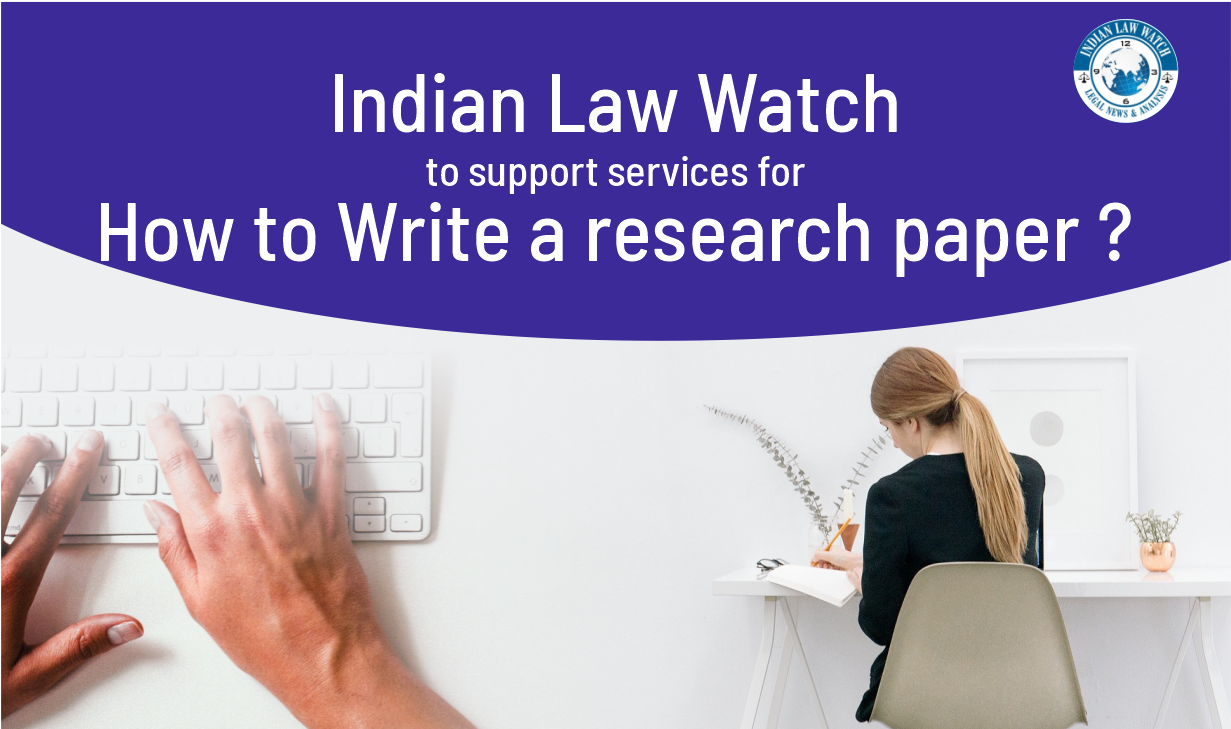
Indian Law Watch to support services for How to Write a research paper
Research is an important tool and publications are important resource materials. Indian law students should be encouraged to write such paper in the areas of their interest. This guide walks you through everything you need to do to write an effective, impactful research paper for both college assignments as well as publications in journals. You can contact us for the support services provided below.
What is a research paper?
A research paper requires you to do extensive research on a particular topic by analyzing existing literature or empirical data. Unlike articles, which largely require the author’s opinion and point of view, a research paper is based on facts. Essentially, a research paper requires you to form an opinion on a topic, research, and gain expert knowledge on that topic, and then back up your own opinions and assertions with facts found through your thorough research. Unlike articles, research papers are more formal and sometimes even have a bland language which strips the writing of any bias.
| HEADING | INDIAN LAW WATCH SUPPORT |
| Guidance on queries about to which journal to write a research paper, what topic to check. Answering about any problematic areas like relevant research material, about Guidelines, choosing a topic. | @ Rs. 200 per query Write to us for your query on indianlawwatch14@gmail.com Each question is treated as a separate query. |
| Proofreading the prepared article. | @Rs.700/- Send us your research on indianlawwatch14@gmail.com and we will share our comments about the strength of your article. |
| Support for reviewing outcome of your outline of your preliminary reading | @ 700/- Send us your research links outline on indianlawwatch14@gmail.com and we will share our comments about the strength of your work. |
| Review of Abstract | @700/- Abstract is very crucial and our inputs can help you better sieve the content. |
| Review your International Submission | @1000/- Send us your research on indianlawwatch14@gmail.com and we will share our comments about the strength of your paper. |
| Get your citations fully checked | @ 500/- Send us your research citation details on indianlawwatch14@gmail.com and we will share our comments and correctness. |
Pay for your service required on Paytm no. 8800968714 and mail us your query or WhatsApp on 8800968714 for us to pursue the same.
What should be the length of a research paper?
Usually, the length of a research paper is 4000-6000 words but is also common for journals and colleges to ask for 2000 words short papers or 8,000-10,000 words long papers.
How to start writing a research paper?
Here are a few steps to guide you:
Understand the guidelines.
If you are here to take guidance for a college assignment, your first step should be to understand the assignment for not only the area of research but also the technical requirements such as length, citation style, formatting etc. If you are here to learn how to get a research paper published in a journal, your first step is to research and find journals that match your area of interest. While looking for a journal fit for you, you should make sure that the same is approved by the University Grant Commission. As UGC will consider your article valid only when you submit it to the UGC Approved Journals. Another thing to keep in mind is whether the journal is taking submissions any time soon and how long they take to review and respond.
Choose a Topic
Some journals specify a broad area of research in their call for papers while others accept any topic related to the stream they are concerned with, e.g., law. In an open-ended call for papers, the author must choose their own topic. While it may seem simple enough, choosing a topic is the most important decision you’ll make in writing a research paper, since it determines everything that follows. Your top priority in how to choose a research paper topic is whether the topic interests you enough to spend an hour of research on it and form an opinion. The next priority is whether it will provide enough content and substance for an entire research paper. However, you should avoid general topics which have been discussed at length with the same angle of research and instead stick with topics specific enough that you can cover all the relevant information without cutting too much.
Preliminary Readings
Now that two difficult tasks are behind us, the next step is to have a basic idea about the topic of research before diving into the depth of it. Start pulling out literature related to the topic and start reading. For preliminary research, it is enough to use basic search engines to look for articles and papers that will help you grab some basic ideas. You can also use databases like Jstor, Hein Online, Kluwer and Lexis Nexis etc. depending on your stream. Further, for this step, when gathering your research, it’s better to skim sources instead of reading each potential source fully. If a source seems useful, set it aside to give it a full read later.
Create an Outline
After having a basic idea about the topic, draw up a working mind map or outline for your paper. Essentially, create a rough structure. Include any important, interesting, or provocative points, including your own ideas about the topic. A mind map is less linear and may even include questions you want to find answers to. Essentially, this step is simply to collect your thoughts and group ideas logically to streamline the research.
Then, start with making a list of all the important categories and subtopics you need to cover—an outline for your outline. Consider all the information you gathered when compiling your supporting evidence and ask yourself what the best way to separate and categorize everything is. Once you have a list of what you want to talk about, consider the best order to present the information. Which subtopics are related and should go next to each other? Are there any subtopics that don’t make sense if they’re presented out of sequence? If your information is fairly straightforward, feel free to take a chronological approach and present the information in the order it happened.
Writing Abstract
Using what you found in your preliminary research and the map you created, write an abstract that succinctly summarizes what your research paper will be about. An abstract makes it easier for other researchers to assess whether or not your paper is useful to them for their own research. Some journals ask for an abstract submission before the final submission, to decide whether your thought process and idea for the paper is something they would like to publish in their journal. Therefore, this makes it important for you to write a succinct abstract. The idea is to mention all the important parts of the discussion without disclosing too many details. If you’re having trouble putting it into words, try to phrase your topic as a question and then answer it.
Begin writing
Start with writing the body of the paper, instead of starting with the introduction. As the introduction is the first thing reader would read after the abstract, it needs to cover the gist of your paper and introduction to the research properly. Therefore, it is usually advised to write it once you are done with the main body and conclusion of the paper. The outline and abstract you had prepared will now serve as an assistant to streamline your research. Now you can read in debt about the sub-topics you had divided earlier and focus on covering the points you mentioned in the abstract.
Follow along your outline and go paragraph by paragraph. Because this is just the first draft, don’t worry about getting each word perfect. Later you’ll be able to revise and fine-tune your writing, but for now, focus simply on saying everything that needs to be said. In other words, it’s OK to make mistakes since you’ll go back later to correct them. One of the most common problems with writing long works like research papers is connecting paragraphs to each other. The longer your writing is, the harder it is to tie everything together smoothly. Use transition sentences to improve the flow of your paper, especially for the first and last sentences in a paragraph. Even after the body is written, you still need to know how to write a conclusion for a research paper. Just like an essay conclusion, your research paper conclusion should restate your thesis, reiterate your main evidence, and summarize your findings in a way that’s easy to understand.
Citation
The last second step is to begin citing the sources as per the preferred style of citation mentioned in the guidelines. The key to getting the citations right is to prepare a format while reading the citation style for each reference type you have used. There are two most common citation styles used Bluebook and Oscola. Various websites provide a summary of these citation styles, that you can refer to. Citations may seem confusing at first with all their rules and specific information. However, once you get the hang of them, you’ll be able to properly cite your sources without even thinking about it. Keep in mind that each formatting style has specific guidelines for citing just about any kind of source.
Proofreading
This is the final stage, where you want to go through your draft and correct all the mistakes by proofreading. It is also usually suggested to take assistance from your friends, seniors, or teachers to not only critically analyze your paper but also check for errors in writing style.
A few suggestions for the structure of
Introduction
The introduction requires a short review of the topic at hand. The introduction is then best constructed as a descriptive funnel, starting with a broad discussion on the topic and slowly focusing on the work at hand. Briefly describe the approach that was taken to test the hypothesis. Finally, a summary sentence may be added stating how your research will contribute to the overall field of study.
Main Body
The main body should be divided into various sub-themes to make the article crisp and interesting for the readers. Try to use short yet catchy subheadings, make sure the sub-heading are in coherence with the text and give a proper introduction to subheadings.
Conclusion
First, introduce the work and then briefly state the major results/concluding remarks. Then state the main points of the discussion. Finally, end with a statement of how this work contributes to the overall field of study.
- Do not introduce new topics/facts/ideas in the conclusion.
- Start with summarizing what you have discussed above and then give concluding remarks.
- Avoid using facts in this part.
Do’s and Don’ts
Do’s
- Use short and crisp sentences and paragraphs. Long and complex sentences can be boring to read. Start with a briefing about the topic or the field of concern. Shorter sentences make it easier for the reader to pay attention. Further, shorter sentences make it easier for the reader to remember key takeaway points. If your paragraphs are long or if your sentences are rambling, the reader will quickly become bored and frustrated. Even worse, the reader may gloss over your main points!
- Use transition words. Make it easy for the reader to follow your line of reasoning. Use words like “moreover,” “in addition,” and “however” to introduce paragraphs. This helps your final product “flow” and it makes it easier for the reader to follow. It also makes your writing look less choppy and more cohesive.
- Use the active voice. In active voice, the “subject” of the sentence is doing the action and the “object” is affected by the action. An example of active voice is, “The boy threw the ball.” The subject (the boy) is doing the action (throwing the ball). In contrast, in the passive voice, the object becomes the subject. Active voice is easier to read. It keeps the reader’s attention and it also gets to the point. Thus, the majority of your writing should be in the active voice. (Note: Sometimes the passive voice is appropriate– e.g., if you want to deflect attention away from the subject or actor, such as your client. However, it should be used strategically in legal writing.)
- Cite everything that is not your opinion– anything other than your personal opinion should be cited, it can be opinions by other people or facts.
Don’t’s
- Don’t use first-person except, in conclusion, that too when necessary.
- Don’t Start the article with a question, suggestion, and complex sentence.
The first sentence is vital in any piece of writing, including academic writing. It’s one of the first things a reader will see and it gives them a lasting first impression of your paper. It needs to draw the reader in and show them how important, interesting and relevant your research is. What should the first sentence look like?
Remember these few points
- Should be short – You’ll also lose readers if your first sentence is long and complex. Your research might be complex, but you don’t need to cover all the nuances and exceptions in the first sentence. Try to keep it simple (avoid sub-clauses) and short.
- Should not be a suggestion/question/vague– Leaving your first impression open to interpretation is risky. Vagueness is never good in an academic paper – you should always be specific and clear in what you’re saying. This is especially true for the first sentence.
- Should tell you clearly what the paper is about.
- Should be definite, straightforward statements.
- Should make you want to read on. A dull opening could be the exit point for your readers. What would you want to read? Think about why you’re interested in the topic and enthuse other people with an interesting first sentence – they’ll keep reading.
- Don’t use ‘maybe’, ‘perhaps’, or ‘I think.’ be bold in your writing!
- Don’t state your personal opinion without backing it up with authorities. The reader is not particularly interested in what you think. The reader is interested in whether you have a sound legal argument to support your position. For this reason, you should be careful of the word “I” and other personal pronouns. Do not state, “I believe that…” Instead state, “In light of the case law, it is clear that…” Making the habit of avoiding personal pronouns will help you to use law, rather than opinion, to make your arguments.
- Avoid jargon and verbosity.
- Avoid repetition– Do not repeat facts/words/opinions. This makes the article monotonous.





